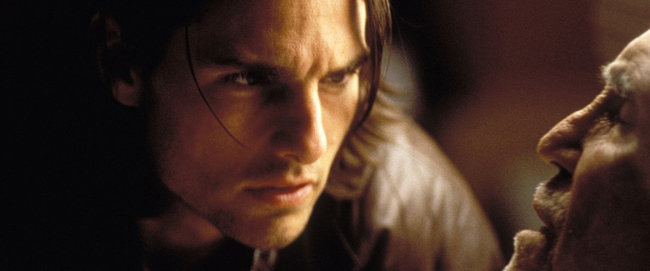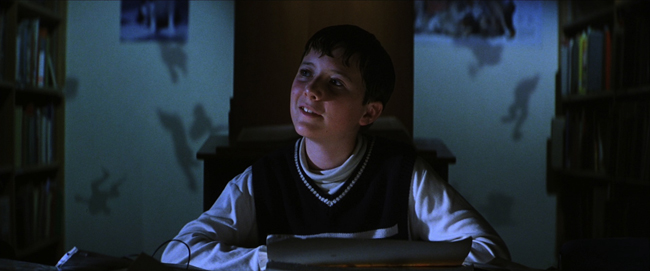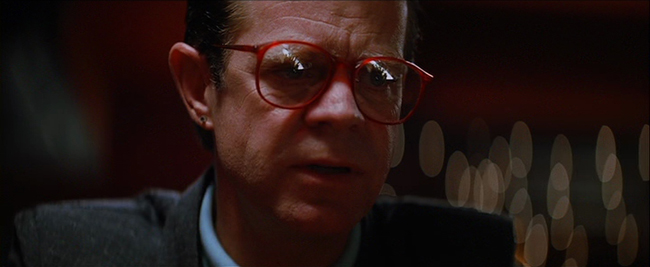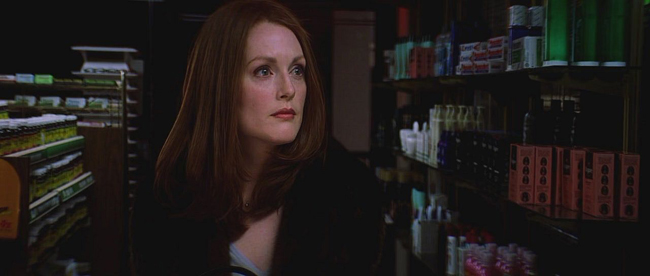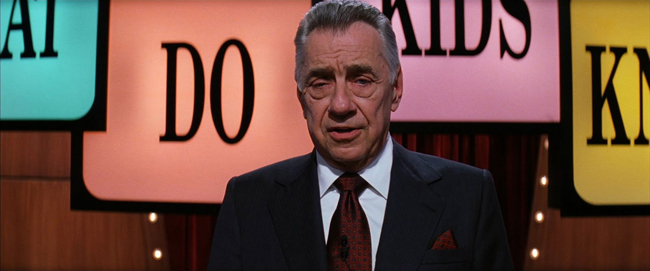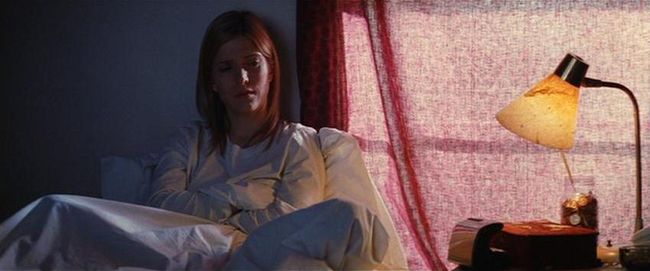 The Power of Song
The Power of Song
Magnolia
published in Real Time Nos. 36/37, Sydney, 2000I have no idea why Paul Thomas' Anderson's film is called Magnolia (1999). Nor do I particularly care why it is called Magnolia. This is but one of near-countless incidental beauties of the film. I have a lot to say about this film - but maybe you've already heard all that needs to be said about such a film. Pompous. Pretentious. Preposterous. Long-winded. Cold-hearted. An ensemble cast like Robert Altman. Tracking shots like Scorsese. Three goddamn hours long. Simply, what you've heard is wrong.
Scorcese's Good Fellas (1992) is undoubtedly a masterpiece, whether I wish it to be or not. It is a carbon-compacted diamond of modern film narrative, compressing a century of story-telling into an adrenaline vocal stream of violent drama, not unlike the steaming spittle direct from Scorcese's own bearded mouth. It is the end of a genetic line of narrative that draws with incredible skill on just about every key mechanism that safe critical orthodoxy deems integral to the cinematic apparatus. Robert Altman's Short Cuts (1993) is not a masterpiece as such because the grand mantle of modernist narrative is not the spectacular crown it seeks. If Scorcese is the talker, Altman is the listener: he takes in all and allows all to be said. As a 'good ear', he stands in stark contrast to Scorsese who flits like a caffinated psychologist playing back his patients' taped neuroses in fast-forward. Short Cuts is an attempt to listen to the noise of social dysfunction while retaining the integrity of its pain. When that ringing sound overcomes Christopher Penn in a moment of murderous rage, Altman does not merely tape: he induces feedback as a profound statement on the looping inevitability of actions which decimate all that we - as subjects and writers of our own fiction - wish to control.
Scorsese is about voice; about the pace of its delivery, the heightened points of its enunciation and all the tragi-comic collapses which follow its peppered emissions. Altman is about time-and-space; about the way in which a zone is fixed, locked and delineated to ensnare and entrap all within its resonating psychological perimeters. His camera work is the tracing of flow lines between radio-miced performers improvizing in real time. It is a televisual effect and actually shares little with the relentless scopic 'proscenia' of cinema's fractured denouement - which Scorsese both destroys and regales in the operatic shock waves that define his giddy camera work. And in case you're missing the point here: the tracking shot of the opening to The Player is not the tracking shot of the rear-entrance nightclub scene in Good Fellas. Nor is it the tracking shots at the poolside party of Boogie Nights (1997) or in the TV station of Magnolia P.T. Anderson's tracking shots are dictated not by location value, character insight, plot machination or wannabe auteurism, but by music. I contend that P.T. Anderson is about song - and as such is virtually a new species of narrative when compared to the likes of Scorsese and Altman.
Lili Zanuck's Rush (1991), Ulu Grosbard's Georgia (1995), Spike Lee's Clockers (1995) & Girl 6 (1996), Alison Anders & Kurt Voss' Grace Of My Heart (1996) & Sugartown (1998), The Coen Brothers' The Big Lebowski (1998), Todd Haynes' Velvet Goldmine (1998) - all critically declaimed films of the 90s; all films which aspire to the condition of music generally, song especially. Equally significant is the way these films employ songs, many of which would have yielded me decidedly less pleasure beyond their cinematic placement. Waging a critical battle against my sense of 'taste' in music, these films uncomfortably inhabit my mental space despite my measures to reduce them into a wobbly chimera of what my cinematic mind imagines them to be. From Lee's fundamental reliance on the r'n'b/soul ballad, to Zanuck & Grosbard's retrieval of the 'singer-songwriter' stigma free of the dogma which stifles its historicist rock journo flatulence, to the Coen's uncompromising eclecticism, to Haynes, Anders & Voss' sincerity in re-evaluating the lost repositories of the neo-decadent lines between Glam and New Romanticism - these directors (and their composers and music supervisors) innately and personally know the power of song. And they have accordingly allowed song primacy of place in their radiophonic narratives. In an era where directors have proven themselves to be absolute retards when it comes to pop music, their cinema is sonically intelligent and musically literate.
Only a fool would still refute that the most ungainly and septic pop song is incongruously capable of sublime and transcendental expressions of irrational emotional fluxes and states. You can import every post-Adorno treatise on the bankruptcy of the pop machine to fend off the power of the song, but it will be to no avail. And to surrender to this is a lesson not only in how the significance and persuasiveness of the pop song can embody one in its aural aura, but also how its signage and effects result from dense, modular and multi-layered striations which literature will never shape in the span of two-and-a-half minutes. For the pop song is dimensional: it engulfs one in the fantasy terrain of its own imagined social space; sometimes courting you, other times repelling you, always affecting you.
A bar scene in Magnolia. Ex-quiz kid Donnie Smith (William H. Macy) bursts through the padded door into its red ". The song is one of a few hits from their successful Breakfast In America LP from 1979 - a melodious monstrosity of corporate rock from a dinosaurian era. It harbours something more than 'bad taste'. Like all corporate radiophonic diaspora, it recalls every social environment it has stained. The aura is deafening: a flood of all public space where that song played comes back to haunt one as you sit there overwhelmed by memories of every tiled surface, sticky carpet, flocked-wallpaper and buzzing fluoro light which has shaped your phenomenological make-up. It's personal because of its ability to jettison you back to those dimensions all at once. Stomaching this song is meant to be emotionally visceral. It is not about deftly choosing an emotional state and sound to synchronize dramatic energy (as is the case with Scorsese's canny use of Nilsson's 1973 song "Jump Into The Fire" as a coked-up Johnny [Ray Liotta] does a drug run near the climax of Good Fellas). P.T. Anderson's use of Supertramp's Goodbye Stranger is meant to create a psycho-sonic space wherein we become ensnared by both the song and the cruel tragedy which unfurls around Donnie as the song reaches its own gaudy epiphany. Donnie is of course oblivious to the song, yet we share his trauma by having it amplified for us by a song to which he is indifferent.
That is what P.T. Anderson can do with songs. It is a device - an art, even - which he has been doggedly honing since Hard Eight (1997) and Boogie Nights. Don't take my word for it. In the liner notes to the Magnolia CD he writes: "Like one would adapt a book for the screen, I had the concept of adapting Aimee (Mann's) songs into a screenplay." I picked this up the first time I saw Magnolia. It became even more apparent on second viewing, so reading this quote afterwards was gratifying and inspiring. This guy knows song. If you think you 'know' cinema, then you probably will not like Magnolia. It is working beyond your ontological schema of conditional cinema; it is working in the dense fibrous sonorum of pop music, record production, and the strikingly ambivalent evocation specific to lyric writing. And if you don't know song - its flirtatious socio-cultural pomp and circumstance - then you will likely have difficulty in comprehending the grain of Magnolia's narrational voice and how it speaks the evaporative dance of sound waves and song lines which define its story. Magnolia reaches new heights of 'vertical narration', where everything is told - as songs do - 'all at once'. Despite all the claims to its liberating play with the imagination, literature is comparatively burdened by its own linearity, so when P.T. Anderson choses to not adapt a book for the screen and choses a set of songs by Aimee Mann instead, his resulting mode of narration will only laterally connect to those narrative forms we expect from cinema. Magnolia is thus a timbrel text which must be listened to in order for it to be read.
People who reductively and programmatically think film making is about 'telling stories' really should just role over and die. They say they want story telling as if it is some universal essential act, when what they invariably seek is a bourgeois mish-mash of classical Greek theatrical dogma, countless Judeo-Christian hang-ups about authorship, stains left over from Joseph Campbell's limp leaking dick, and a PDF file downloaded from a Sid Fields fanboy site. All this fretting over plot, character, motivation, structure, truth, honesty, meaning - all dished out in mean-spirited, narrow-minded terms of condition. Territorialized, categorized, rationalized, franchised; all in the name of a cheap mimetic humanism which even dogs would find suspicious and unconvincing. Notably, Magnolia fails abysmally under such strictures. Following the surreal 'preface' to the film, the introductory character-based movement to Magnolia unfolds. It fucks with your aural consciousness so deeply it's like being shot at close-range and not feeling the pain until the paramedics shove a needle into you. It tells you so much and with such an excess of simultaneity you loose sense of narrative linkage and progression. Deliberately so. Magnolia is not about biblical resonances, chance occurrences, fatalistic arcs and other linear logic which it sardonically quotes. It is about the dissolution of narrativity in the confluence of multitudinous potentiality which vibrates like a chorus of narrational pulsars in harmony with the songs on its soundtrack. This is how one can start to classify Magnolia as a 'new species of narrative'.
Across that opening survey of all the film's characters, Aimee Mann's cover version of Harry Nilsson's "One" occupies both screen and auditorium in a radical way. It is the nearest American cinema has come to the work of Jean Luc Godard and his sound designer Francois Musy in films like Detective (1982), Hail Mary (1985), Soigne Ta Droite (1986) & Nouvelle Vague (1990). Yet whereas the Godard/Musy sono-musical collages take on a fractal complexity in their horizontality via their dramatic cut-and-splicing, P.T. Anderson's mix of Aimee Mann's cover version (produced and performed by the film's composer Jon Brion) throws us into an equally complex verticality. In concert with the like-minded mind-boggling sound design by Richard King, the "One" sequence ducks and weaves all its soundtrack elements within and without the architecsonic domain of the song "One". What is most amazing is the flagrant disregard for formal hierarchical logic in the sound design: Aimee Mann's 'lead vocals' ride atop for most of the time (panned hard right in the mix to leave dialogue in the centre), yet at times even her voice is clouded by the film's dialogue and the song's own baroque vocal arrangements.
A vocal schizophrenia is thus orchestrated, typical of the pleasurably perplexing arrangements of Brian Wilson and Van Dyke Parks to which Jon Brion stylistically bows. This chorus of expressive utterances breathes in a continually morphing sonorum which is, literally, breath-taking. All the characters are at some point out of breath, running and rushing headlong into a story of fatalistic eruption. As with Orson Welles' mix of vocal layers in Citizen Kane (1941) and Altman's peak in overlapping dialogue in California Split (1977), Magnolia features many show pieces where vocalization and legibility precariously come near to cancelling each other out. Because the film attempts too much? Because P.T. Anderson is grandiose? No: because the flow lines of character energy in Magnolia chart the ways in which those characters are running out of time as their connections with each other contract into a net of inescapable embraces and releases. Every nano second of the film's editing, cross-fading and mixing volumetrically gauges this momentum with vibrancy and urgency.
The Brian Wilson/Van Dyke Parks connection is not accidental. These two artists - along with others like Phil Spector and Jack Nitzsche - constitute a white rock/pop sensibility integral to the post-60s history of West Coast record production. Running parallel and counter to the obvious and comparatively shallow 'mind expanding' gestures which coloured the Haight-Ashbury adventures in poor studio experimentation, Wilson, Parks, Spector and Nitzsche used the recording studio not as a stage for the spectacular breaking of taboos, bit rather as a dark closet of manic-depressive, schizophrenic and psychotic fissions which they aurally and musically workshopped. Wilson and Spector in particular led quite tragic lives as child prodigies which blossomed in radiophonic glory and slowly withered through a series of non-commercial catastrophes which are now appreciated as uncompromising excavations of personal grief. Both Donnie Smith and young Stanley (Jeremy Blackman) in Magnolia are personality amalgams of these figures, with Stanley standing in for the celebration of youth and Donny being a sad visage of being trapped by that youth.
Schizophrenia here is not a term to be taken lightly, and the mix of Magnolia is crucial to the film's habitation of one's aural consciousness. Many characters in the film quote "You may be done with the past, but the past is not done with you", and the film accordingly lives simultaneously in its past and in its present. Its characters contend with guilt, grief and anguish not for the vainglorious sake of literary exposition and contemplation, but more so to construct a therapeutic realm within which one can experience those sensations through being incapable of escaping them. The characters of Magnolia are not 'vessels': they are amplifiers, speakers and transmitters of a psycho-space. They voice the noisy ward within which you are interred for the duration of the film's gathering. Listen to The Beach Boys' "Good Vibrations" (1966, or just about any track from the Wilson/Parks productions of Pet Sounds, 1966 & Smiley Smile, 1967). The key changes and cascading harmonies are like the Swingle Singers attempting to lip-sync to themselves in front of fun parlour crazy mirrors. The sensation is like having too many people talking to you at once, and the fact that they harmonize in a series of rounds suggests that they have a cohesion and logic which further intimidates the isolation of your own voice. Throughout Magnolia Aimee Mann's songs fuse, blend and curdle the score by Jon Brion. On many occasions - and this, for me, is bliss - multiple musics occur simultaneously. The effect is so unsettling one realizes why cinema desperately avoids it, especially when pools of dissonance spill into the auditorium.
The skill and craft with which P.T. Anderson and Richard King have landscaped pools of dissonance and waterfalls of consonance over the undulating emotional field of Magnolia will prove a seminal text for the 'de-operization' of the cinema in years to come. A lofty claim on my part, but Magnolia is a sign of how one can collapse the architectural fascism which has rendered cinema as monolithic, monoglotic and monogrammatic - as a form predicated on constructing heroic edifices, elevated plains and panoramic vistas of enlightenment. Even though the film appears to have been targeted by many as being all these things and more, I would argue that Magnolia eschews the operatic by incisively strewing its high art baggage like the scorched remains at a plane crash site. Magnolia is not registered in the hyper-monodical heights of art cinema which tackily imports opera onto its soundtrack with all the subtlety of a drag queen from the 60s. When Magnolia employs the most saturated aria - yes, from Puccinni's Madame Butterfly - it does so with a clinical, scrutineering ear. It plays out unedited against a scene of Jim Guerney (John C. Reilly) and Claudia Gator (Melora Walters) engaged in a tragi-comic first meeting at her flat. The scene is banal, flat, pregnant, empty; all the melodic drama of Puccinni eventually withers and seeps into the walls, spent and exhausted. No, Magnolia is about as 'operatic' as Diva is subtle.
Maybe it is a drained diva that sails along the emotional waves of Magnolia. The voice of Aimee Mann is clearly a sono-lyrical love object for Anderson throughout the film. He enshrines it and allows it to mix freely with his film. Her voice is itself ingrained with characteristics which allow her to vocalize a line enriched by a tradition that embraces other singer-songwriters like Joni Mitchell and Carole King - each icons of West Coast 70s music, the latter the fictionalized subject of Alison Anders' Grace Of My Heart. While I don't buy into the rock journo rhetoric which mythologizes the singer-songwriter, the maturity and sensitivity conveyed by Aimee Mann's songs deserve the aural fawning Magnolia accords them, and the production by her, Jon Brion and others is far more eclectic and far less prosaic than the 'naturalism' which made West Coast rock the aural equivalent of a smelly crocheted vest. The polyglottic instrumentation of her songs adds much to Magnolia's aural palette, and are measured carefully against her grain: a mix of ennui, insouciance and world-weariness.
This contrast of abject vocal grain against elaborate ornamental instrumentation is signposted very early in the film in two important instances. First is when Aimee Mann's voice first sounds with vamped piano chords and a full black screen. Who is she? Where is she? What is her purpose? She is the voice from a nowhere that will map the somewhere of the film. Second - and as equally epicentral to the film's oral centrality - is the bizarre audiovisual zoom into the decaying throat of Earl Partridge (Jason Robards) as he hoarsely whispers through the frenetic cellular activity which signals his body's surrender to cancer. He rasps in the mix the way a tuba or trombone emits a gritty pink noise in digitally-clear orchestral recordings: the grain is unbearably tactile. Just as you could smell death on his breath, you can feel its presence on your own eardrums.
Cancer, of course, is the draining life force of Magnolia. The film profoundly addresses this in a series of terse refutations, negations and denials which never let up. Just as Partridge is himself a cancerous cell in the glandular familial spread of all the film's characters, so too does each and every person expel and repeat his infected breath one remove from their own emotional death. In fact all the key emotional points performance-wise are presented through debilitating inversions of vocal power: Mrs. Partridge (Julianna Moore) provides numerous black holes of gasping and gnashing as she deals with Earl's demise; Frank Mackie (Tom Cruise) breathlessly vomits years of hatred over Earl on his death bed; Claudia vents a volcanic ocean of steaming rage when her father Jimmy Gator (Philip Baker Hall) intrudes upon her frail sanctity.
Richard King's sound design for Magnolia follows what could be deigned a cancerous spread: voices and music leak through thin walls; TVs crackle indifferently, indignantly and incessantly, oxidizing the most private domains; car sound systems carry their passengers within their darkened subsonic wombs; music cues well up and spill over into scenes for which they were destined as well as those poised innocently adjacent; and radio playlists infect public spaces like a cold in an air conditioned office. Sound in Magnolia is thus mostly about that which you wish to suppress, engaging you in a wearing psycho-acoustic fight with the film's soundtrack: you strain to hear, you wish for silence, you attempt to focus, you achieve your own noise threshold. And just as the film is structured around song's ability to be 'all at once', its score around a 'complex verticality', its narrative around an 'excess of simultaneity, so is its soundtrack an overload of all that impedes the act of listening. The end result is a story about exhaustion, drainage, and the fulsome quiet which comes only after trauma with substance.
For what it's worth as far as image goes. The poster for Magnolia features a clear blue sky out of which fall some frogs. That may be one way of explaining the plot of the film. Or as Stanley the child brain says after exhaustive research in his school library about inexplicable phenomenae: "It's just something that happens." The CD cover for Magnolia features the eponymous flower with all the film's characters softly super-imposed on its erotic petals. A strange orb of flora vibrates at its centre, resembling a strange planet around which the characters orbit. That may be one way of illustrating how we connect uncontrollably to others. Thankfully, I still do not know why the film is called Magnolia.
Text © Philip Brophy 2000. Images © New Line Cinema

